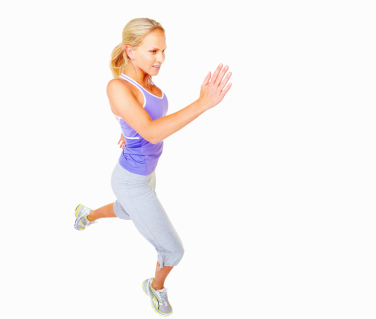Regain Fitness After an Injury
by Shawn
(Buffalo, NY)

I recently fractured my fibula (4 weeks ago) and according to the doctor I am a little over half way there with my predicted recovery.
I have only been running for about two years but I have seen consistent improvement with my race pace over that time (as much as 6 minute decrease in 5k races over the last year).
Can you please give me some advice for any exercises/activities that I can do so that I can regain my pace?
I know that it will take time (just not 2 years again I hope) so I am not looking for a quick fix.
I will be limited with the boot on my leg for the next 4 weeks, but I am looking for something that I can do for my lung capacity and muscles (which have seen a dramatic decrease in size in my right leg).
Thanks in advance.
Answer by Dominique:
Hi Shawn,
Thanks for your question about recovering from a fibula fracture. It's tough to have to take a break from running, but there are still ways to stay active and maintain your fitness. Let's explore some options that can help you get back to your pace and even improve it once you're fully recovered.
Let's cover off on:
1. Upper-Body Exercises for Cardiovascular Health
2. Benefits of Upper Body and Core Strengthening
3. Circuit Training
4. Returning to Running Safely
Upper-Body Exercises for Cardiovascular Health

But you can focus on upper body exercises to keep your heart rate up and maintain your cardio fitness.
With a leg in a moon boot you are going to be restricted in what you can do. The ski erg could be a good machine to get into. It requires upper body movements mostly. Still, there is dependency on being stable on your legs. So, you may have to take it easy. But it is the first exercise that comes to mind that provides a strong cardiovascular workout and "leaves the legs alone".
Benefits of Upper Body and Core Strengthening

Simply put, a stronger body makes for a stronger runner. A strong core helps stabilize your body when running, improving your posture and preventing injuries. And while ideally you'd be working on the legs as well, you can still get a good workout with upper body work alone.
It will all help you become a stronger and more resilient runner in the long run. Also see my Strength Training for Runners page.
Circuit Training

Clearly, you will have to work out which exercises you can and cannot undertake with the fibula. But it should be possible to get a set of 5-10 exercises together. You can do 10 repetitions of each exercise in a row without stopping. Then take a minute rest. And repeat. Depending on strength and fitness you can do this as many times as you want.
Even a 10 lbs medicine ball gets heavy very quickly with this type of conditioning work! This form of workout can help you maintain a level of fitness and can keep you motivated during your recovery period.
Returning to Running Safely

But give it time. Start with light jogging or brisk walking to ease back into running and assess how your leg responds. Avoid pushing yourself too hard or too soon, as this can lead to setbacks in your recovery. Gradually increase your mileage first and keep the running intensity low. Also see the Increasing Mileage Safely page.
Once you have built up some endurance as well as some confidence that your leg is fully healed, then start adding back some intensity. This slow and steady approach is generally not what we want, but allowing your body to readjust to the demands of running will reduce the risk of re-injury. For some ideas on types of workouts to consider, check out the Running Workouts page.
You mention the reduced strength in the right leg. Follow your doctor's advice on when you can start doing strength training with the legs and what types of activities are permitted. But I'd definitely advocate for some lower body strength training.
Not sure how long it will take to get back to your old self. A reasonable rule of thumb says it will take about the same time as the down time you have experienced. So, don't worry, it will not take two years to get back to your previous levels of fitness. 2-3 months is likely a more reasonable estimate.
I wish you all the best in your recovery journey, Shawn. If you have any more questions or need further guidance, feel free to reach out. Take care and keep moving forward!
Kind regards,
Dominique


